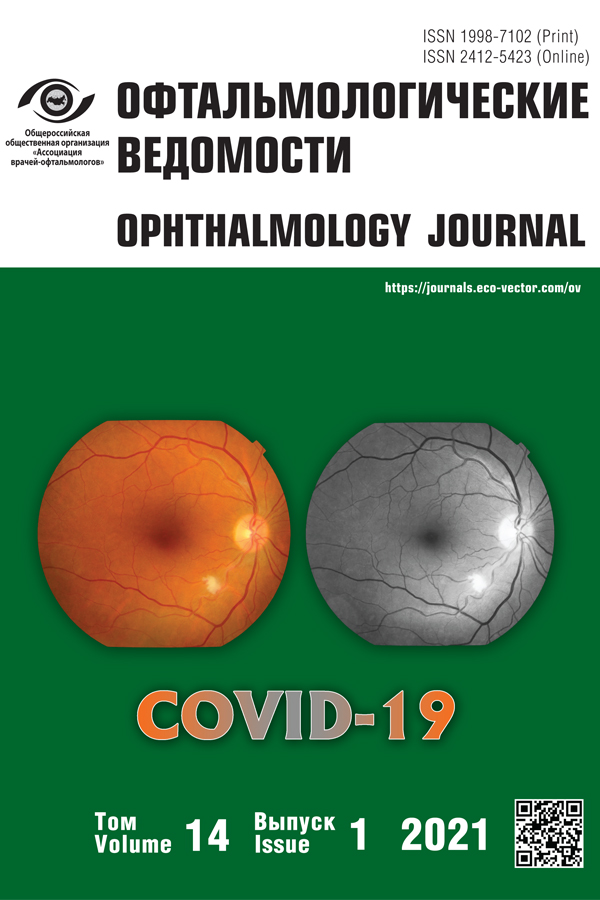Effects of treatment interruption on anatomical and functional status of eyes with neovascular age-related macular degeneration receiving anti-VEGF therapy
- Authors: Kharakozov A.S.1, Kulikov A.N.1, Maltsev D.S.1
-
Affiliations:
- S.M. Kirov Military Medical Academy
- Issue: Vol 14, No 1 (2021)
- Pages: 35-42
- Section: Original study articles
- Submitted: 03.02.2021
- Accepted: 21.03.2021
- Published: 09.06.2021
- URL: https://journals.eco-vector.com/ov/article/view/59966
- DOI: https://doi.org/10.17816/OV59966
- ID: 59966
Cite item
Abstract
AIM: To study anatomical and functional changes in eyes with neovascular age-related macular degeneration (AMD) receiving anti-VEGF therapy and experienced treatment interruption during COVID pandemic.
MATERIAL AND METHODS: This retrospective study included 58 eyes (49 patients, 34 males and 15 females with a mean age of 73.2 ± 9.4 years) with nAMD. Eyes in the first-year treatment group (18 eyes) received up to 7 intravitreal aflibercept injections, eyes in the second-year treatment group (21 eyes) were treated with pro re nata regimen. The treatment interruption period in the first and second-year treatment group was 5.5 ± 0.7 and 5.5 ± 1.0 months, respectively.
RESULTS: Over the treatment interruption period, the first-year treatment group showed no statistically significant differences in best-corrected visual acuity (BCVA) and central retinal thickness (CRT), p = 0.25 and p = 0.09, respectively. At the same time, the second-year treatment group showed a statistically significant decrease in BCVA (p = 0.0004) and an increase in CRT (p = 0.002). Baseline BCVA was positively associated with BCVA at the end of treatment interruption (r = 0.82; p < 0.0001). Presence of sub- and intraretinal fluid (p = 0.015 and p = 0.007, respectively), low BCVA (p < 0.0001), high CRT (p = 0.019), alteration of the ellipsoid zone (p < 0.001) were negatively associated with BCVA at the end of treatment interruption. Age (p = 0.8), gender (p = 0.41), and the number of intravitreal injections (p = 0.5) showed no association with changes in BCVA.
CONCLUSIONS: NAMD patients of the second year of anti-VEGF therapy appear to have a higher risk of functional loss during treatment interruption. Higher CRT and lower BCVA, as well as sub- and intraretinal fluid before treatment interruption, are associated with poorer functional status at the end of the interruption period.
Full Text
About the authors
Alexandr S. Kharakozov
S.M. Kirov Military Medical Academy
Author for correspondence.
Email: kharakozoff@mail.ru
ORCID iD: 0000-0003-4598-0826
SPIN-code: 1208-5237
graduated
Russian Federation, 6 Aсademiс Lebedev str., Saint Petersburg, 194044Alexey N. Kulikov
S.M. Kirov Military Medical Academy
Email: alexey.kulikov@mail.ru
ORCID iD: 0000-0002-5274-6993
SPIN-code: 6440-7706
Scopus Author ID: 57001225300
ResearcherId: M-2094-2016
MD, PhD, Dr. Sci. (Med.)
Russian Federation, 6 Aсademiс Lebedev str., Saint Petersburg, 194044Dmitrii S. Maltsev
S.M. Kirov Military Medical Academy
Email: glaz.med@yandex.ru
ORCID iD: 0000-0001-6598-3982
MD, PhD
Russian Federation, 6 Aсademiс Lebedev str., Saint Petersburg, 194044References
- Regillo CD, Busbee BG, Ho AC, et al. Baseline predictors of 12-Month treatment response to ranibizumab in patients with wet age-related macular degeneration. Am J Ophthalmol. 2015;160(5):1014–1023. doi: 10.1016/j.ajo.2015.07.034
- Hayashi H, Yamashiro K, Tsujikawa A, et al. Association between foveal photoreceptor integrity and visual outcome in neovascular age-related macular degeneration. Am J Ophthalmol. 2009;148(1):83–89. doi: 10.1016/j.ajo.2009.01.017
- Kharakozov AS, Kulikov AN, Maltsev DS. Predictors of functional outcome of antiangiogenic therapy in neovascular age-related macular degeneration. Ophthalmology Journal. 2020;13(4):7-13. (In Russ.)] doi: 10.17816/OV46198
- Ou WC, Brown DM, Payne JF, et al. Relationship between visual acuity and retinal thickness during anti-vascular endothelial growth factor therapy for retinal diseases. Am J Ophthalmol. 2017;180:8–17. doi: 10.1016/j.ajo.2017.05.014
- Boiko EV, Maltsev DS. Quantitative optical coherence tomography analysis of retinal degenerative changes in diabetic macular edema and neovascular age-related macular degeneration. Retina. 2018;38(7):1324–1330. doi: 10.1097/IAE.0000000000001696
- Kulikov AN, Sosnovskii SV, Berezin RD, et al. Vitreoretinal interface abnormalities in diabetic macular edema and effectiveness of anti-VEGF therapy: an optical coherence tomography study. Clin Ophthalmol. 2017;11:1995–2002. doi: 10.2147/OPTH.S146019
- American Academy of Ophthalmology. Alert: Important coronavirus updates for ophthalmologists. March 23, 2020. Available at: https://www.aao.org/headline/alert-important-coronavirus-context. Accessed: 25.03.2021.
- Antaki F, Dirani A. Treating neovascular age-related macular degeneration in the era of COVID-19. Graefes Arch Clin Exp Ophthalmol. 2020;258(7):1567–1569. doi: 10.1007/s00417-020-04693-w
- Wong DHT, Mak ST, Yip NKF, et al. Protective shields for ophthalmic equipment to minimise droplet transmission of COVID-19. Graefes Arch Clin Exp Ophthalmol. 2020;258(7):1571–1573. doi: 10.1007/s00417-020-04683-y
- Sacconi R, Borrelli E, Vella G, et al. TriPla regimen: A new treatment approach for patients with neovascular age-related macular degeneration in the COVID-19 “era”. Eur J Ophthalmol. 2020;7:1120672120963448. doi: 10.1177/1120672120963448
- The Royal College of Ophthalmologists (2020) Medical retinal management plans during COVID-19. Available at: https://www.rcophth.ac.uk/wp-content/uploads/2020/03/Medical-Retinal-Management-Planduring-COVID-19-UPDATED-300320-1-2.pdf. Accessed 25.03.2021.
Supplementary files












